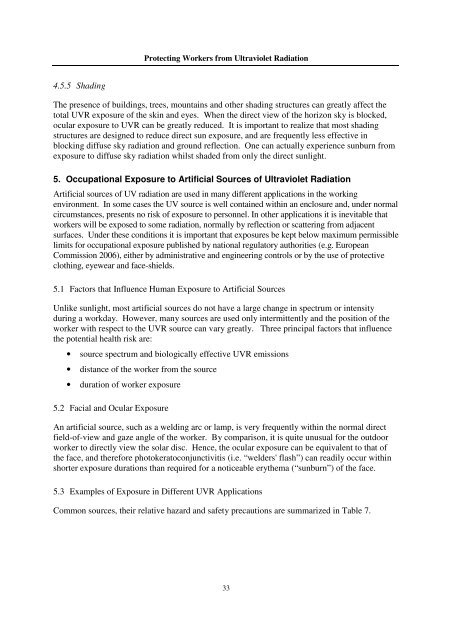Protecting Workers from Ultraviolet Radiation - icnirp
Protecting Workers from Ultraviolet Radiation - icnirp
Protecting Workers from Ultraviolet Radiation - icnirp
You also want an ePaper? Increase the reach of your titles
YUMPU automatically turns print PDFs into web optimized ePapers that Google loves.
4.5.5 Shading<br />
<strong>Protecting</strong> <strong>Workers</strong> <strong>from</strong> <strong>Ultraviolet</strong> <strong>Radiation</strong><br />
The presence of buildings, trees, mountains and other shading structures can greatly affect the<br />
total UVR exposure of the skin and eyes. When the direct view of the horizon sky is blocked,<br />
ocular exposure to UVR can be greatly reduced. It is important to realize that most shading<br />
structures are designed to reduce direct sun exposure, and are frequently less effective in<br />
blocking diffuse sky radiation and ground reflection. One can actually experience sunburn <strong>from</strong><br />
exposure to diffuse sky radiation whilst shaded <strong>from</strong> only the direct sunlight.<br />
5. Occupational Exposure to Artificial Sources of <strong>Ultraviolet</strong> <strong>Radiation</strong><br />
Artificial sources of UV radiation are used in many different applications in the working<br />
environment. In some cases the UV source is well contained within an enclosure and, under normal<br />
circumstances, presents no risk of exposure to personnel. In other applications it is inevitable that<br />
workers will be exposed to some radiation, normally by reflection or scattering <strong>from</strong> adjacent<br />
surfaces. Under these conditions it is important that exposures be kept below maximum permissible<br />
limits for occupational exposure published by national regulatory authorities (e.g. European<br />
Commission 2006), either by administrative and engineering controls or by the use of protective<br />
clothing, eyewear and face-shields.<br />
5.1 Factors that Influence Human Exposure to Artificial Sources<br />
Unlike sunlight, most artificial sources do not have a large change in spectrum or intensity<br />
during a workday. However, many sources are used only intermittently and the position of the<br />
worker with respect to the UVR source can vary greatly. Three principal factors that influence<br />
the potential health risk are:<br />
• source spectrum and biologically effective UVR emissions<br />
• distance of the worker <strong>from</strong> the source<br />
• duration of worker exposure<br />
5.2 Facial and Ocular Exposure<br />
An artificial source, such as a welding arc or lamp, is very frequently within the normal direct<br />
field-of-view and gaze angle of the worker. By comparison, it is quite unusual for the outdoor<br />
worker to directly view the solar disc. Hence, the ocular exposure can be equivalent to that of<br />
the face, and therefore photokeratoconjunctivitis (i.e. “welders' flash”) can readily occur within<br />
shorter exposure durations than required for a noticeable erythema (“sunburn”) of the face.<br />
5.3 Examples of Exposure in Different UVR Applications<br />
Common sources, their relative hazard and safety precautions are summarized in Table 7.<br />
33



